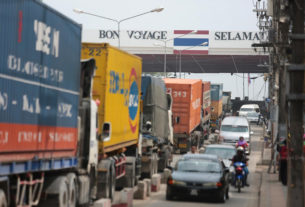Chevron hopes to advance the startup of a $3.1 billion natural-gas project in the Gulf of Thailand to this year, in the latest step by the U.S. major to cash in on booming Asian demand for cleaner-burning fuels.
The acceleration of the timetable for the Platong II project from 2012 reflects rising Thai consumption of natural gas, Chevron’s President of Asia Pacific upstream activities, Jim Blackwell, said in a ceremony to mark the completion of the project’s main gas-processing platform.
Chevron owns 69.8% of Platong II, which aims to process 420 million cubic feet a day at its peak. Output would roughly meet 10% of Thailand’s natural-gas demand, which Energy Minister Wannarat Charnnukul forecast last month will climb 6.1% this year to 4.34 billion cubic feet a day.
Separately, Thailand expects to start receiving liquefied natural gas through its first import terminal, with an annual capacity of five million metric tons, in the second half of 2011, Thai energy ministry Deputy Permanent Secretary Kurujit Nakornthap said on the sidelines of the ceremony Wednesday.
“Its construction will be completed by the end of June,” though the terminal in Eastern Thailand will likely operate at 20% of its capacity in the first one-three years, he said.
Chevron’s partners in the Platong II project are Mitsui Oil Exploration Co. Ltd. and Thailand’s state-owned PTT, the country’s largest energy conglomerate by sales, will buy all the gas for supply to customers including its subsidiaries in the petrochemical industry.
The California-based Chevron is placing a series of multibillion dollar bets on natural gas in the Asia-Pacific region, where growth in greenhouse gas emissions due to a reliance on crude oil and coal is spurring governments to promote cleaner-burning fuels.
Natural gas consumption in Asia’s emerging economies, led by China and India, is projected to rise 65.4% to 463 million metric tons of oil equivalent in the 2008-2020 period, the International Energy Agency says.
Many of Chevron’s investments are focused on expanding its footprint in China, the region’s largest economy, or developing trillions of cubic feet of natural gas reserves offshore Australia that can be cooled to a liquid and shipped northward to energy-deficient nations like Japan.
However, Platong II will further entrench Chevron in Thailand, where natural gas already meets around a third of the country’s electricity demand. Much of this supply comes from the Gulf of Thailand, where Chevron operates 14 blocks.
In addition to developing its own reserves, Thailand is investing heavily in natural-gas infrastructure to meet future demand, including pipelines from offshore fields in Myanmar and the liquefied natural gas receiving terminal being built by a unit of PTT around 100 miles from Bangkok.
Also in Southeast Asia, Chevron is also targeting a decision on whether to formally invest in the $4 billion Block B natural-gas project offshore Vietnam by the end of the year.
Last month, the company advanced its $6 billion-$8 billion deep-water Gendalo-Gehem project off Indonesia–its single largest investment in the country–by awarding engineering and design contracts.
